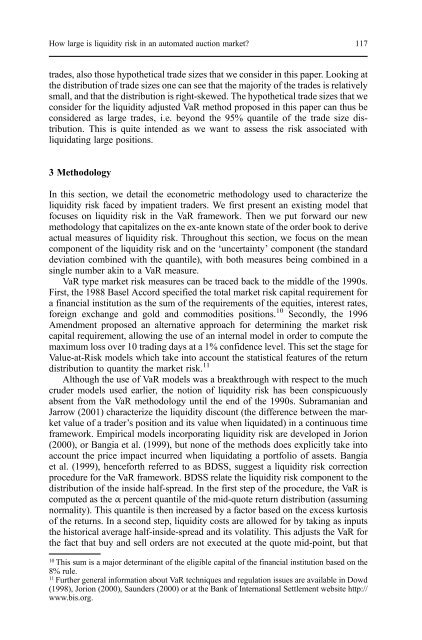recent developments in high frequency financial ... - Index of
recent developments in high frequency financial ... - Index of
recent developments in high frequency financial ... - Index of
You also want an ePaper? Increase the reach of your titles
YUMPU automatically turns print PDFs into web optimized ePapers that Google loves.
How large is liquidity risk <strong>in</strong> an automated auction market? 117<br />
trades, also those hypothetical trade sizes that we consider <strong>in</strong> this paper. Look<strong>in</strong>g at<br />
the distribution <strong>of</strong> trade sizes one can see that the majority <strong>of</strong> the trades is relatively<br />
small, and that the distribution is right-skewed. The hypothetical trade sizes that we<br />
consider for the liquidity adjusted VaR method proposed <strong>in</strong> this paper can thus be<br />
considered as large trades, i.e. beyond the 95% quantile <strong>of</strong> the trade size distribution.<br />
This is quite <strong>in</strong>tended as we want to assess the risk associated with<br />
liquidat<strong>in</strong>g large positions.<br />
3 Methodology<br />
In this section, we detail the econometric methodology used to characterize the<br />
liquidity risk faced by impatient traders. We first present an exist<strong>in</strong>g model that<br />
focuses on liquidity risk <strong>in</strong> the VaR framework. Then we put forward our new<br />
methodology that capitalizes on the ex-ante known state <strong>of</strong> the order book to derive<br />
actual measures <strong>of</strong> liquidity risk. Throughout this section, we focus on the mean<br />
component <strong>of</strong> the liquidity risk and on the ‘uncerta<strong>in</strong>ty’ component (the standard<br />
deviation comb<strong>in</strong>ed with the quantile), with both measures be<strong>in</strong>g comb<strong>in</strong>ed <strong>in</strong> a<br />
s<strong>in</strong>gle number ak<strong>in</strong> to a VaR measure.<br />
VaR type market risk measures can be traced back to the middle <strong>of</strong> the 1990s.<br />
First, the 1988 Basel Accord specified the total market risk capital requirement for<br />
a f<strong>in</strong>ancial <strong>in</strong>stitution as the sum <strong>of</strong> the requirements <strong>of</strong> the equities, <strong>in</strong>terest rates,<br />
foreign exchange and gold and commodities positions. 10 Secondly, the 1996<br />
Amendment proposed an alternative approach for determ<strong>in</strong><strong>in</strong>g the market risk<br />
capital requirement, allow<strong>in</strong>g the use <strong>of</strong> an <strong>in</strong>ternal model <strong>in</strong> order to compute the<br />
maximum loss over 10 trad<strong>in</strong>g days at a 1% confidence level. This set the stage for<br />
Value-at-Risk models which take <strong>in</strong>to account the statistical features <strong>of</strong> the return<br />
distribution to quantity the market risk. 11<br />
Although the use <strong>of</strong> VaR models was a breakthrough with respect to the much<br />
cruder models used earlier, the notion <strong>of</strong> liquidity risk has been conspicuously<br />
absent from the VaR methodology until the end <strong>of</strong> the 1990s. Subramanian and<br />
Jarrow (2001) characterize the liquidity discount (the difference between the market<br />
value <strong>of</strong> a trader’s position and its value when liquidated) <strong>in</strong> a cont<strong>in</strong>uous time<br />
framework. Empirical models <strong>in</strong>corporat<strong>in</strong>g liquidity risk are developed <strong>in</strong> Jorion<br />
(2000), or Bangia et al. (1999), but none <strong>of</strong> the methods does explicitly take <strong>in</strong>to<br />
account the price impact <strong>in</strong>curred when liquidat<strong>in</strong>g a portfolio <strong>of</strong> assets. Bangia<br />
et al. (1999), henceforth referred to as BDSS, suggest a liquidity risk correction<br />
procedure for the VaR framework. BDSS relate the liquidity risk component to the<br />
distribution <strong>of</strong> the <strong>in</strong>side half-spread. In the first step <strong>of</strong> the procedure, the VaR is<br />
computed as the α percent quantile <strong>of</strong> the mid-quote return distribution (assum<strong>in</strong>g<br />
normality). This quantile is then <strong>in</strong>creased by a factor based on the excess kurtosis<br />
<strong>of</strong> the returns. In a second step, liquidity costs are allowed for by tak<strong>in</strong>g as <strong>in</strong>puts<br />
the historical average half-<strong>in</strong>side-spread and its volatility. This adjusts the VaR for<br />
the fact that buy and sell orders are not executed at the quote mid-po<strong>in</strong>t, but that<br />
10 This sum is a major determ<strong>in</strong>ant <strong>of</strong> the eligible capital <strong>of</strong> the f<strong>in</strong>ancial <strong>in</strong>stitution based on the<br />
8% rule.<br />
11 Further general <strong>in</strong>formation about VaR techniques and regulation issues are available <strong>in</strong> Dowd<br />
(1998), Jorion (2000), Saunders (2000) or at the Bank <strong>of</strong> International Settlement website http://<br />
www.bis.org.










